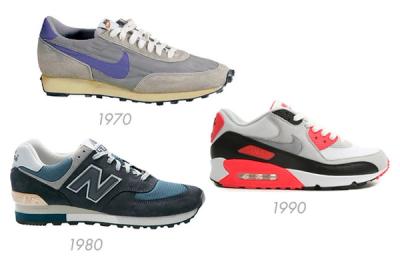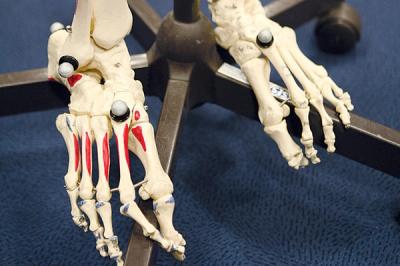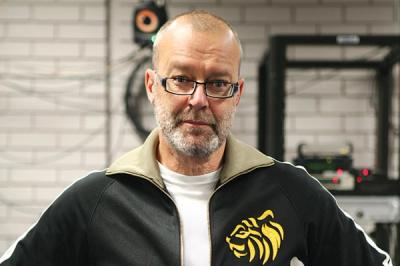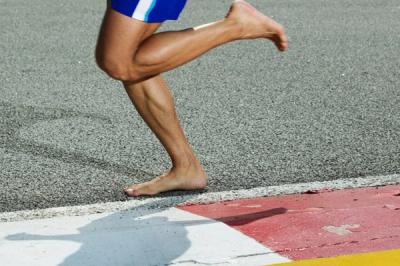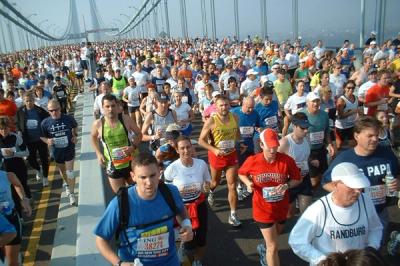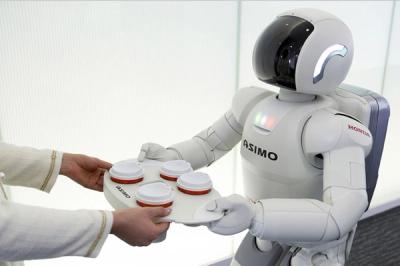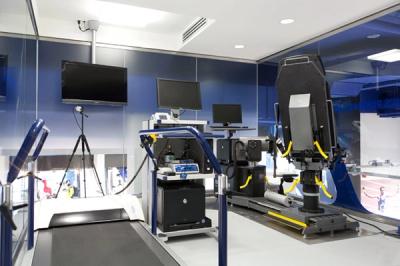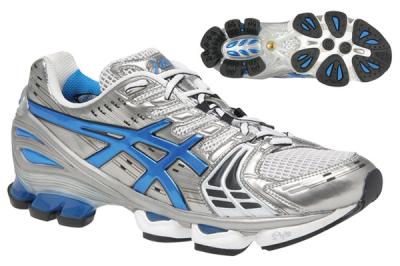Simon Bartold
We like to think we know sneakers, but every now and then we get a reality check from a pro, which is exactly what happened when we ran into Simon Bartold. Podiatrist, biomechanist and self-proclaimed bullshit detector, Simon is also an International Consultant at ASICS, where he scientifically probes their running shoes to verify their bona fides. This was a fascinating conversation and a peek into the future, where high-tech materials could fundamentally change our beloved sneakers forever. Simon also has a warning for all you flat-sole lovers – you may be damaging your feet. Look out!
We’re obsessed about the way shoes look on the outside. My assumption is that you think about shoes in completely the opposite way. Is that a good place to start our conversation?
Yeah it is. Basically my job is to make sure that we build shoes at ASICS that offer the best ride for an athlete. I don’t really care too much about the cosmetics. I care far more about the functionality. But I also understand it’s got to look good.
Are you a medic or a scientist?
It’s all smoke and mirrors really. My background is as a clinical podiatrist. I had my own practice for 22 years and for the last 12 years I only saw athletes. I became more involved in footwear and then biomechanics, which has led to research work with universities and collaborative programs. So I guess I’d consider myself more a biomechanist than I do a podiatrist, although there’s a lot of crossover.
Can you explain the difference?
Well that’s an interesting question. Biomechanics is the science of basically how movement occurs. You can apply biomechanics to an ant or to a human, it doesn’t matter. But in podiatry, the world of biomechanics begins and ends at the foot. It can be anything from understanding blood movement to how we move in sport and injury.
You’re also the international research consultant at ASICS. What does that mean?
It’s a question I get asked often, normally by my family and I find that difficult to answer.
You make it sound mysterious...
Yeah, pretty much! My main job is to oversee the research programs globally. I travel around the world to the hard-core sports medicine conferences to identify trends. Recently we have been working on the vast differences mechanically and physiologically between men and women. At the moment for example, we’ve got a gender study looking at how oestrogen (the main female sex hormone) affects the stretchiness of tendon and ligament. The other side of my job is taking this very complex technical information and making it digestible to average people who don’t have any sort of background in science or biomechanics.
Do you mean the shoe designers?
Sometimes. My job is to distinguish the myth from fact and as you well know, there’s a lot of myths out there. You won’t print this of course, but I see myself basically as a bullshit detector. I’ve got to make sure that we’re not telling stories that we can’t scientifically substantiate and I take that role pretty seriously.
So you’re a scientist, a doctor, a teacher and a bullshit detector?
Yeah, all of those things. I never get bored in this job, it’s pretty cool.
We’ll come back to ASICS later but I wanted to ask you more of a philosophical question. How do you think of feet?
Well where do I start? I think feet are like south-west Tasmania, they’re the last unexplored wilderness really. I was at a really interesting conference just recently where a guy drilled holes into bones to get a handle on exactly how the foot worked and his conclusion was that we may never know because it’s so complicated. Over a quarter of all the bones in the body are in the feet. It’s such a sophisticated structure! Have you seen Asimo the Honda robot? He’s the closest thing to human movement that’s been artificially created...
I’ve seen him fall off the stairs and crack his head. That was too funny...
I haven’t seen him fall off the stairs but I have seen him run and he looks like an old man and the reason is because all the joints are fused. Feet are the platform for our bodies and they have a profound influence on your body from your big toe to the top of your head.
I heard that if you chop off your big toe, it’s impossible to stay upright?
Absolutely. I actually heard of a case where a young kid lost his big toe. In the end they amputated his thumb and grafted it on to his foot. So yeah, if you’re going to lose a toe, you don’t want it to be your big one.
Do we really need shoes? There’s plenty of dudes running around the Kalahari in barefeet!
I think we do, especially in Western societies. We have been wearing shoes for thousands of years and have actually evolved to adapt to a ‘shod’ situation. There’d be many people who argue with that, but I think that we’ve now pretty much established that it’s good to have the heel raised in shoes. About 12mm is a good thing biomechanically, because you’re in a more efficient position. If you’re running around the Kalahari Desert you develop a lot of calluses, but it’s probably still desirable to have a decent pair of shoes rather than doing that barefoot.
I was thinking about the evolution of shoe design. The 1960s was pretty basic. By the 1970s, low profile nylon runners come in and then in the 1980s, shoes are getting bigger and heavier with new technology and crazy marketing concepts such as roll bars, air bags and torsion. That evolved right through the 1990s into more extreme design. Now it seems like we're returning to the early years and things are getting simpler and lighter. Broadly speaking, how do you see that timeline?
I think it's fascinating. As you asked that question I was thinking that shoes have really only started to hit their straps in the last 10 years. If you look at the timeline from '73, which is the birth of technical footwear, what happened is that biomechanics really did become a science. For the first time shoes were subjected to scrutiny. Guys like me started to ask questions like whether motion control was a negative? Scientific questions were asked and we got answers. What we came to understand is that it's like putting a glove on and trying to text your mate on a cell phone. It's extremely difficult because you knock off all the little sensors on your hand, so you don't get the feedback from your hand to the brain which is why we're going back to more flexible, lighter and more compliant footwear. But you still need footwear that's structured and provides some protection. If I had a crystal ball, I would say that I think that footwear is going to get more adaptive.
Do you mean to the surface you're running on?
Yes. It's a brave new world. There's materials on the market now that can do things that we wouldn't have thought possible 18 months ago, it's moving that quickly
Are you talking about foams and gels or actual fabrics?
Foams, gels, upper materials, meshes, linings, everything!
You mentioned before about a 12mm heel height being ideal? Why is that the standard?
Well, that's a very interesting question because it hasn't been settled on at all. With ASICS we've always worked on a 10mm gradient. That's the difference between the height of the forefoot and the height of the rear foot, so if you've got a cushion type shoe it might be 24mm and 14mm off the ground. A racing flat might be slimmer at 10mm and 20mm. We've done a lot of research on this and we understand that it actually puts your foot in a mechanically better position, makes it more stable, takes a load off the Achilles tendon... so there's a lot of positives. There's a lot of myths and all that sort of crap and the problem is that every time you add a little raise, people are going to say ‘oh but you're removing the foot from the ground therefore you're going to make it more unstable and you're more likely to sprain an ankle', which is complete nonsense. That's scientifically unsustainable. There's no evidence to say that happens at all.
Would the average runner notice the difference between a 10mm and 13mm raised heel?
We've actually done what's called a double-blind experiment which means that the researcher doesn't know which shoe the subject's getting and the subject doesn't know either. Across the board, runners prefer the 13mm in terms of performance and comfort. That was a pretty positive result.
Is it true that shoes which are completely flat can cause problems? There's a lot of those around at the minute...
You've got to be really careful that you amortise this to the actual situation. So the thing about kids these days is that hopefully they're pretty active, which means they will need some sort of meaningful midsole and elevated heel. Let's go back to the Kalahari Desert. If you habitually don't wear a shoe with any sort of midsole, you will adapt to that. But then you've got to think about what happens if that kid then wants to go and play tennis or basketball? They are certainly more likely to get injured. Kids have things called growth plates which is a plate of cartilage sandwiched between bone and it disappears by the time you're about 17. The growth plates are normally exactly where tendons insert so they tug on the growth plate. If you get impact on that, especially around the heel, then you are very likely to develop an injury.This is something we've looked at at length, especially in football boots which is why we've had a raise in our boots now for a long time. So yeah, I think walking around in completely flat shoes is less than ideal.
It's a bit off the topic, but are high heels particularly bad?
The simple answer is yes they are. If you're wearing them occasionally, I don't have a problem at all. If you are wearing them eight hours a day, six days a week you will definitely get adaptive changes that will be bad for you. You'll realign your spine and probably get an adaptive shortening of your Achilles tendon which is bad news. You will get a profound increase in loading through your forefoot which will probably affect the joints of your forefoot.
Ok. You mentioned a few footwear myths. Let me throw a few at you.
Myth #1. Expensive running shoes are a waste of money.
Myth.
That was too quick. Are you reading my notes?
I thought you might ask me that.
Well it is a popular one. Journalists love writing provocative pieces about how $300 shoes are for idiots.
Yeah, yeah. I think it's a myth because I suppose I've got a unique insight into what goes into those shoes and just how sophisticated they are. I'm going to put my ASICS hat on now and say ‘okay, well I know the difference between a Gel 1140 versus a 2140'. They are shoes that are quite similar in a lot of ways but there is a big difference between them in terms of what they offer. So it's like saying there's a difference between a standard BMW and an M3. Is that a waste of money? Well it depends on your perspective. There is a quantum difference between the cars at every single level, but it depends how serious you are about driving. So if you're a runner at the pointy end of the race, those shoes are clearly better in terms of performance, ride, protection, all those things.
Durability?
No, durability doesn't vary. It makes no difference whether you're buying a $150 pair of shoes or a $300 pair of shoes.
Ok. Myth #2. Running in barefoot is the best.
Instantaneous bullshit detection going on! This is very popular at the moment and there's a lot of companies that have websites saying that barefoot running is the way to go. But I think if we look at everything that science tells us, which is what we have to place our belief in, then that statement would not ever be supported because of the ability of shoes to help improve biomechanics.
Myth #3. Running shoes should be one size bigger than your standard casual shoe.
No, they shouldn't, but sometimes they can be because there is variation from style to style and also from brand to brand.
In the width versus the length?
Yeah. If your foot slides forward in the shoe, you will inevitably get blisters. They're a response to friction. I think fit is one of the most underrated things in footwear. Fit equals function basically. A shoe can't work unless it fits properly. It's a really, really underrated topic and it's something that will be quite an important area of research in the coming years. Do you know what a brannock device is?
One of those sliding foot measuring things?
Yeah, it was invented 50 years ago. It's a metal plate that gives you a very precise width and length fitting. Years ago, nearly every shoe shop had brannock devices.
People have different sized feet as well.
Absolutely. Most people are very asymmetrical. I've got one thumb that's way bigger than the other thumb.
Myth #4. There's too much marketing and not enough science in running shoes.
Yeah, I think that's right. I have a nice little pyramid and it has the distribution of dollars of marketing versus science and you can guess where all the dollars are distributed. It's one of the refreshing things about working with ASICS. I don't really want to sound like the ASICS guy, but they will kill their own product if they think it doesn't work properly. ASICS is driven by product first and marketing very much second, which is the reverse of most companies.
The last myth I have is one that I hear a lot, and that is that ASICS make the best runners. (Laughs)The people who have told me that don't actually know why they think that. I hear it all the time ‘ASICS are the best shoes for runners'.
Well, I do think that ASICS are acknowledged within the industry as making the most technical runners. Whether that makes them the best or not isn't for me to say. I certainly appreciate the science that goes into them. I think ASICS have been very brave. They made a decision not to stick with the marketing alone and to let universities do their thing and accept the answers without fear or favour.
We don't want to fall into the trap of saying every runner has to have an ASICS shoe because that's not appropriate. When I worked with football clubs, if they were sponsored by a particular brand, every player had to be in that brand. Sometimes you can't fit players to what that brand has to offer. You've just got to be aware of that. It's not a uniform world.
With your background, if someone wants to get into running or step up their activity, how should they determine what shoe suits them the best? Is it by going to see a podiatrist for example?
Yeah, I get asked this quite a bit. I think you've got to weigh up the cost versus benefit. In an ideal world, it's useful to go to a podiatrist and have an analysis and find out how you're put together and what your risk factors are. That makes an assumption that you're dealing with a podiatrist who has a really good grip on biomechanics. If you don't want to do that then the second option is to locate a technical running shoe shop, most of which offer pretty basic gait analysis. They'll be able to get a rudimentary idea of how you roll. And then they certainly should be pretty expert in shoe recommendations.
Can anyone definitely say for certain that shoes can prevent or increase the likelihood of damage?
That is a very controversial question. I think there are now a number of studies that would relate certain types of injury to certain styles of shoe. One of the studies we did looked at hamstring injuries. The problem with hamstrings is that you are very likely to re-injure it within a month. There's been all sorts of theories put forward but there's been no definitive answer as yet. So we used EMG which is where you stick a wire into the muscle to look at the electrical signal. We looked at it using a football boot with a flat plate and one with a raised heel and we were able to pretty much definitely show that it changed the signal on the hamstring muscle definitively. We can't say that the boot will stop you getting a hamstring injury, but we can say it definitely changes the signal on the hamstring in a positive way.
How long does it take ASICS to get a shoe from concept to the store?
It depends on the shoe. Typically if it's a new shoe, it's an 18 month to two year exercise. One of our most recent projects took us about six years to get it from the drawing board into production because we had a vision and we weren't prepared to put it on the market until we achieved that. That was actually the top of the range shoe called the Kinsei. There were no budgets on that shoe's development. We went our hardest and it took us a long time to get that right because it was so technically sophisticated.
Do you have any wild ideas about what we might be wearing in 20 years time?
I've got wild ideas about what we might be wearing in six months time.
I'm not asking whether we'll all be riding hover boards, but I am interested in whether you can foresee a time where we make a quantum progression?
I think the only thing that's limiting us is the materials. The concepts that we know work right now in computer simulation are only limited by the ability for the materials to achieve those goals. I'd be willing to bet a chunk of money that in the next five to ten years we will continue down this very minimalist path and we will probably see shoes that will be incredibly flexible. They will appear to be very simplistic, but they will have materials that respond to load. If you think about Kevlar for example, it's a fabric like cotton but you can fire a bullet at it and it won't go through, because Kevlar develops progressive load. So think about how you can incorporate that into a shoe!
Isn't there some rubber material that if you touch it gently, you can put your finger through easily. But if you punch it, it goes rock hard?
Absolutely. I've just come back from Portland where I met a guy called Martin Shortner who is a biomechanist and he develops materials for Navy Seals. They've got Z-Boats which do 100 miles an hour and they put the Seals in them and of course they're getting the shit kicked out of their knees and ankles when they go across the waves. He developed this material that is incredibly high impact absorbing, a really brilliant shock attenuating material. These materials are out there now, it's just a matter of trying to figure out how to use them. It's fine to have a concept that looks a million bucks on paper and on the computer, but to actually be able to build it can be another story. When all those things come together and we've got better manufacturing capability, I think the product's just going to improve dramatically.
There's gotta be some mad shit left on the Shuttle that we can use? Maybe we need another space race to open it up again?
Funny you say that, one of the materials that we used on the original Kinsei was a material that came out of ceramics technology. It had this incredible moisture-wicking, heat-insulating, heat-reflective performance. Designers take a lot of cues out of the automotive industry, like Formula One, which is pretty cool. I get asked often whether these new materials really make that much difference. Here's another car analogy. A carburettor works just fine but fuel injection works better! Jeremy Clarkson (Top Gear) is a very interesting guy to listen to. People always ask him what his favourite car is... If they asked me I'd say it'd be a Lamborghini but he says the Toyota Corolla is better to drive than a Lamborghini. That's just natural evolution. And it's the same if you look at modern day footwear versus something that's ten years old, there's a quantum difference, it's just a totally different world.
Thanks Simon!

